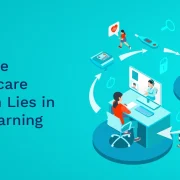
The Role of Simulations in Higher Education Institutions and Colleges
Traditional teaching methods, like lectures and textbooks, are being challenged by technological advancements. Simulation-based learning, powered by Artificial Intelligence and machine learning, offers a more immersive and practical approach. This is useful for STEM and healthcare, where students can apply theoretical knowledge to real-world scenarios. By engaging students in interactive experiences, simulations enhance understanding, critical thinking, and problem-solving skills, leading to better academic performance and career readiness.
Table of Contents:
- What is Simulation in Education?
- Benefits of Using Simulation in Higher Education
- How can Educational Institutions Incorporate Simulations in Their Lessons?
- The Endnote
What is Simulation in Education?
The simulation learning market in the higher education sector is rapidly expanding, driven by the increasing demand for practical, hands-on learning experiences. Simulation in education is a specially designed animated model that looks like a live environment where learners can experience different real-life situations. This is an effort to improve the alignment of coursework and field experiences.
A simulation program can be based on hypothetical situations to study how a system works. These kinds of programs allow the learners to modify the variables in the provided virtual scenario to study the effect of the variables on the processes. Simulation allows the learners to master their skills or tasks without facing any risks. Understanding what is the purpose of simulation is crucial for leveraging its potential in education.
Also Read: Explore Top 5 Simulation Software Tools for Education in 2023
Benefits of Using Simulation in Higher Education
Different forms of media, such as text, graphs, and videos, have significantly contributed to human intellectual progress. While these tools are essential for building a strong theoretical foundation, simulations offer a unique advantage by providing hands-on, real-world experiences. They allow learners to apply their knowledge in a controlled environment, bridging the gap between theory and practice.
Simulations are a valuable tool in higher education for several reasons:
1. Computational Learning
Being a computational learning medium, simulations in education allow students to interact with real-world problems or learning scenarios, implement their theoretical knowledge, and observe the outcome without any real loss. Instead of explaining the real-life processes through words, simulations provide a virtual model of a system that students can explore.
2. Responsive Education System
Many students find that their academic knowledge doesn’t fully prepare them for real-world challenges. Simulations offer a valuable solution by providing hands-on experience in realistic scenarios. This allows learners to apply their knowledge and develop practical skills without the risks associated with traditional learning methods.
For example, science students can conduct virtual chemistry or physics experiments in a safe and controlled environment. Unlike real-world labs, virtual labs eliminate the risk of accidents and minimize costs.
3. Connecting to the Real World
Unlike traditional education systems, simulations allow learners to refine their skills in strategic thinking, teamwork and leadership, system operations, problem-solving, decision-making, and so on in a safe environment. They can enjoy exploring practical situations without bearing any real loss. This is one of the biggest benefits of using simulation technology in education.
Simulation training programs allow learners to implement their skills and knowledge in a computer-generated situation, which mimics a real-life scenario with variant changing facilities. Therefore, they can enjoy the advantages of a practical working experience and identify solutions that they can utilize in their professional lives.
4. Interactivity
Simulation-based education uses simulation software, tools, and serious games to enrich the teaching and learning processes. Thanks to many advances in computer hardware and software, simulations incorporate innovative methodologies that make them more interesting to the next-gen students. Being tech-savvy, Gen Z students enjoy learning through simulation-based education tools to enhance their learning experience.
5. Versatility
As digital, most simulation tools can be accessed through different devices, including computers, laptops, mobiles, and tablets. So, the learners will have access to their virtual learning material from anywhere and anytime; they just need a device and network connectivity to attend their classes.
6. Cost-Efficiency
One of the major benefits of using simulation in higher education is its cost-efficiency. In the case of simulation training, the institution has to invest once in setting up the infrastructure; there are no recurring expenses in terms of equipment and materials, unlike a regular lab.
How can Educational Institutions Incorporate Simulations in Their Lessons?
The question of how simulations can be used in education is increasingly relevant in today’s digital age. Simulation-based learning allows educational institutions to provide a hands-on learning experience to students. For the implementation of effective simulation, three elements are necessary: preparation, active student participation, and post-simulation debriefing.
1. Preparation
Though instructional simulations can be very effective for learning, they need pre-simulation lesson preparation. For successful implementation, there are some important criteria, such as:
- Simulations should be focused on the course goals.
- Facilitators need to be knowledgeable about the supporting material for the simulation.
- Facilitators need to be well-trained in the program’s functionality and must participate in the simulation before assigning it to students.
2. Active Student Participation
Simulation education or training will be successful when students are actively engaged. To achieve the best outcome, students should be explained the key takeaways from their participation in the program.
3. Post-Simulation Debrief
A post-simulation discussion with students should follow every session to explain the deeper learning of the session. The instructor should provide proper information to the students about what they learned from the simulation.
There are multiple ways to incorporate stimulation in an educational system, such as:
1. Use of Simulation Tools
The use of simulation tools in the education system is not new; more than 50 years ago, the analog computer was invented for the simulation of mathematical functions. There are multiple simulation tools available on the market today that are suitable for physics experiments and instrument modeling.
Simulation tools for the healthcare department are designed to serve as an alternative to real patients to attain different clinical skills through ‘hands-on’ practice. It allows trainees to make procedural mistakes and learn from their experiences without the fear of causing any sort of harm to real patients.
2. Screen-Based Simulations
With proper programming, computer-supported interfaces and software are the most suitable ways to implement simulation in different courses. These screen-based simulations allow the learners to interact with the system and hone their knowledge.
3. Implementation of Virtual Interfaces
By combining certain hardware with relevant software, educational institutions can create their course-specific virtual reality with the appropriate working environment. Whether it is a virtual lab for science experiments or virtual aircraft for trainee pilots, it can have a significantly positive effect on learning and achievement.
Also Read: The Legal Framework Surrounding Alt Text for Accessibility in Higher Education
The Endnote
Higher education institutions can revolutionize their courses and teaching methods with simulations, making them more engaging and relevant to today’s tech-savvy students. This powerful tool benefits both learners and institutions, providing a cost-effective, tech-driven solution to mimic real-world scenarios.
Hurix Digital offers innovative simulation solutions that can transform your institution’s educational landscape. Our simulations provide immersive, real-world experiences that enhance student engagement, critical thinking, and practical skills.

Senior Vice President – Business Development
at Hurix Digital, with over 25 years of experience in EdTech and workforce learning. He excels in business development, customer relationship management, and scaling digital learning solutions, driving global growth through innovative content, simulations, and AI‑driven training offerings




